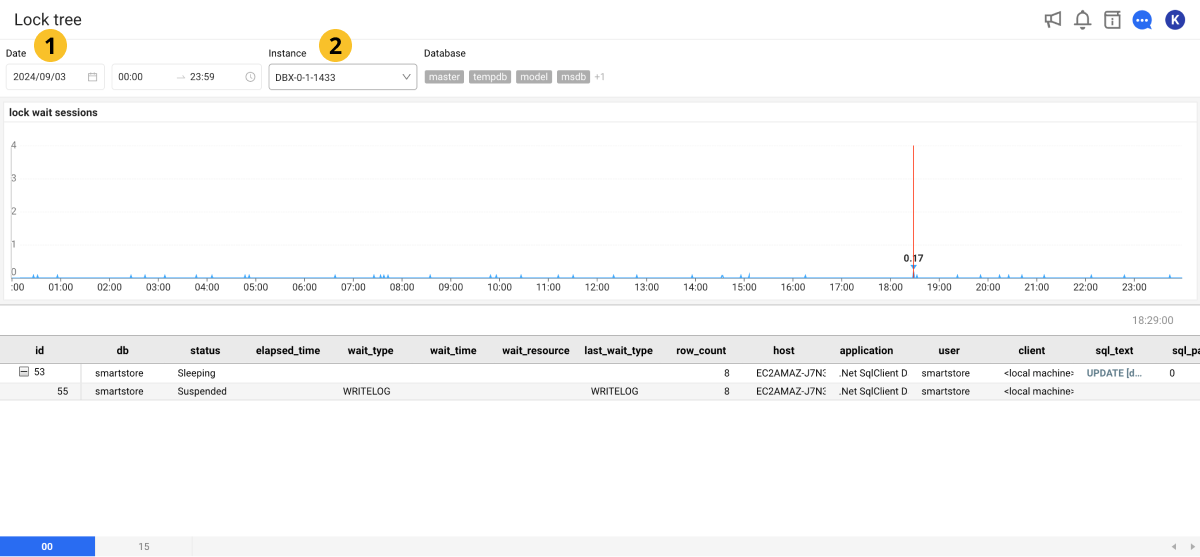Lock tree
Home > Select Project > Analysis > Lock Tree
SQL Server is a useful tool to monitor the locking status occurring in the database in real time and check detailed information related to the lock of a session. This feature allows users to quickly identify locking issues that may cause database performance degradation and analyze its cause.
The provided key features are as follows:
-
Lock status visualization: You can check the locks that occurred during the day in a visualized graph. This allows you to see the time zone and frequency of the locks occurred.
-
Provision of session information: It provides detailed information about the sessions that caused the lock in a table format. You can check information such as each session status, waiting time, waiting type, and SQL statement being executed.
Basic usage guide

-
Select the date to view and set the time in Date at the top of the screen.
-
Select an instance to monitor.
You can check the lock that occurred during the set time on the selected instance.
If a lock occurs during the set period, you can analyze whether lock occurrences are concentrated in a specific time period or whether a specific session continuously causes locks in the lock wait sessions graph and the table at the bottom.
You can see the data in 5-second increments by dragging within 3 hours on the chart. However, the data in 5-second increments can only be viewed within the most recent month. The data earlier than one month can only be viewed as 5-minute summary data. For example, you can drag (drill down) lock tree data from 40 days ago for the 5-minute summary data, but you cannot see 5-second data.
Column information guide
Details for each session are provided in the following columns:
| Item | Description |
|---|---|
application | Name of the application that created the session. |
client | Name or IP address of the client that created the session. |
db | Name of the database to which the session is connected. |
elapsed_time | Elapsed time (milliseconds) since the session started. It is used to measure how much time has passed since a lock occurred. |
host | Name of the client host that created the session. |
id | Unique ID for the locked session. |
last_wait_type | Last type that the session waited for. |
row_count | Number of rows processed in the session. |
sql_param | Parameter value of the SQL statement running in the session. |
sql_text | Entire text of the SQL statement running in the session. |
status | Current status of the session. For example, there are running, suspended, sleeping, and such which indicate whether the session is active or waiting. |
user | Name of the user connected to SQL Server. |
wait_resource | It indicates the resource the session is waiting for. |
wait_time | Time (milliseconds) that the session has been waiting. |
wait_type | Type of wait the session is in. For example, it includes information such as lock wait or IO wait. |
WhaTap basically stores the client-related information.
wait_type
The wait_type column is a value that indicates a specific resource or event on which a query or transaction is waiting in SQL Server. SQL Server uses various wait types internally to manage the system performance and diagnose problems.
I/O-related waits
-
PAGEIOLATCH_EX: It waits for an exclusive lock to read a data page. -
PAGEIOLATCH_SH: It waits for a shared lock to read a data page. -
FILEIO: It waits for a file I/O operation.
Lock-related waits
-
LCK_M_X: Exclusive lock wait. -
LCK_M_S: Shared lock wait. -
LCK_M_U: Update lock wait. -
RESOURCE_SEMAPHORE': Resource semaphore wait when waiting to acquire memory resources.
Other waits
-
CKPACKET: Inter-thread synchronization wait in parallel queries. -
ASYNC_NETWORK_IO: It waits for network I/O operation to be processed. -
SLEEP_*: It is waiting due to aWAITFORorWAITFOR DELAYstatement. -
BROKER_*: It waits for a service broker message. -
LOCK_MANAGER: Lock management waits and the waits related to the lock manager in SQL Server.
wait_resource
The wait_resource column provides information about the resource on which a request running in SQL Server is waiting. A string for a request waiting for a specific resource indicates the specific ID or location of the resource being waited for.
For key resource types and examples, see the following:
-
PAGE: <file_id>:<page_id>It indicates a wait for a data page.
e.g.
PAGE: 1:12345 -
FILE: <file_id>It indicates a wait for the entire data file.
e.g.
FILE: 1 -
0BJECT: <cobject_id>It indicates a wait for a specific table.
e.g.
0BJECT: 123456 -
DATABASE: <database_id>It indicates a wait for a specific database.
e.g.
DATABASE: 5 -
KEY: <key_id>It indicates a wait for an index key or a key of another data structure.
e.g.
KEY: 67890 -
RID: <file_id>:<page_id>:<row_id>If the
wait_resourcecolumn isRID(Row Identifier), it indicates a wait for a specific row in SQL Server.RIDis a unique ID that identifies a specific row in a table in SQL Server.e.g.
RID: 1:1234:5678
-
<file_id>represents the ID of the data file. -
<page_id>represents the page ID. -
<object_id>represents the ID of the table. -
<database_1d>represents the ID of the database. -
<key_id>is the key ID. -
<row_id>represents an ID that identifies a row within the page.